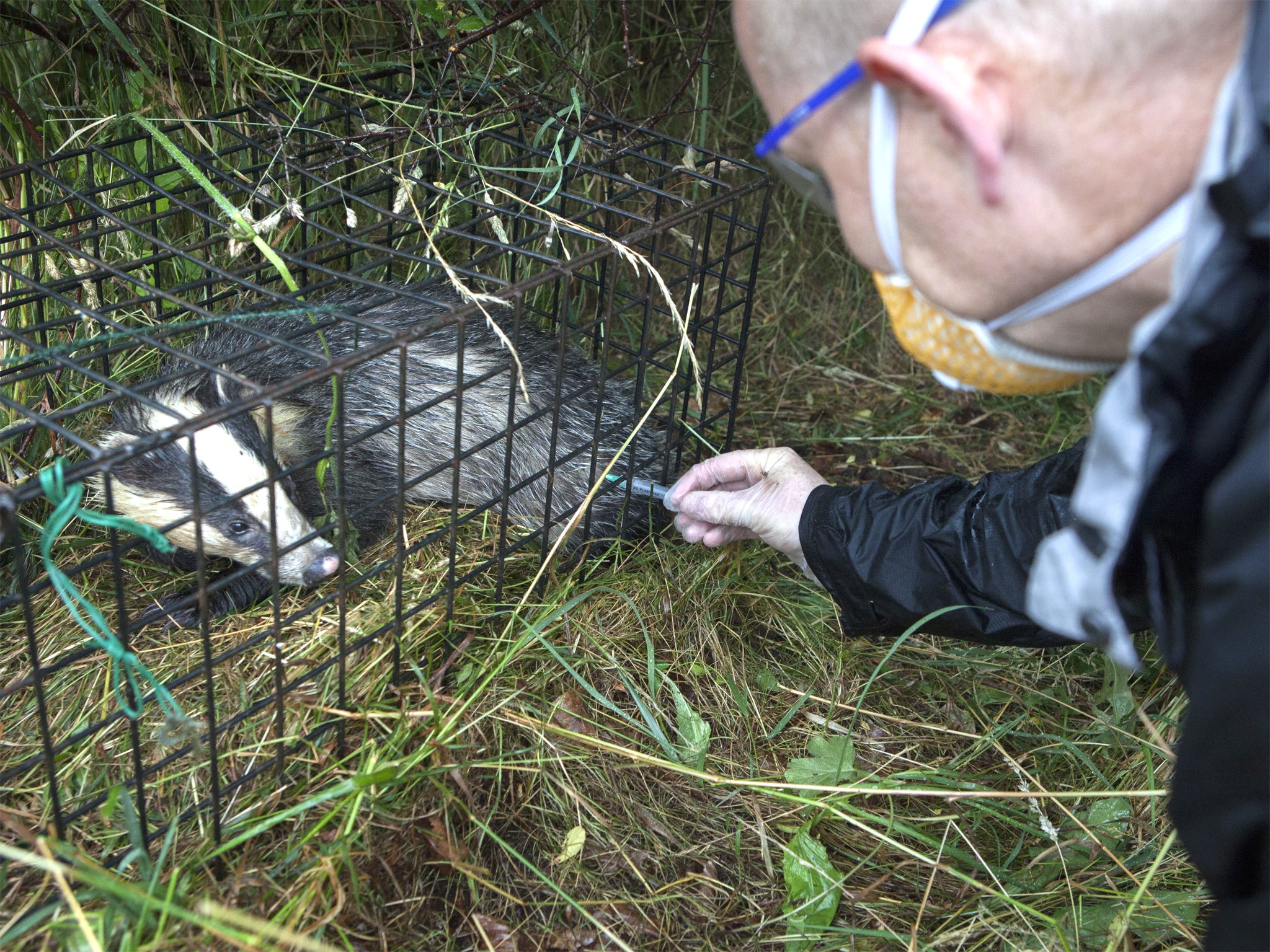How do you vaccinate a badger? Very, very carefully
A curious Tom Bawden joins David Heath, the Farming minister, on the front line of the battle against bovine tuberculosis

Badgers love the taste of peanuts – so much so, they are even prepared to spend a night behind bars for just a single mouthful of the beloved snack.
The mammal’s addiction was only too obvious at 5am in the morning. Together with the Farming minister, David Heath, The Independent has ventured out to a field near Stroud in Gloucestershire, tagging along with an official badger vaccination team.
As the vaccinator injects badgers trapped the night before in baited cages, Mr Heath wonders how often the same animal might fall for the bait-and-cage ruse. Not very often, he assumes. “If you catch them two nights running then it must be a very stupid badger,” he muses, against a classic Cotswold landscape of rolling wooded hills and grazing cattle.
In fact, the area’s chief vaccinator tells us it’s actually quite common for badgers to spend consecutive nights in the pen – they know because they spray the badger with a temporary green dye after the inoculation.
“They get so addicted to the peanuts they are prepared to get trapped in the cage again. It shows that the cage can’t be that uncomfortable, but they also love the nuts. This is great for us because it makes the badgers more likely to bring others back for nuts when we come here next,” said the vaccinator – who did not wish to be identified due to the hysteria surrounding the cull, even though most campaigners would back vaccination as an alternative.
His team tends to spend two consecutive nights at each site to ensure they get as many badgers as possible, and they reckon about 30 per cent of the creatures they capture on the second night are returning visitors.
This particular vaccination team will inoculate about 1,000 badgers this year at 115 sites spread over 95 square kilometres in the Gloucestershire countryside. They are part of a wider vaccination programme that is central to the government’s campaign to cut down bovine TB in cattle by inoculating the badgers that are widely believed to help spread the disease.
It is meant to complement other disease-reduction measures, such as the controversial badger cull and a vaccination for cattle. But Mr Heath argues that inoculations are of little use in areas where the disease is already endemic because it does not provide a cure – while a cattle vaccination could be up to 10 years away.
Still, the vaccination programme here in Gloucestershire represents an impressive option. The preparations begin 10 days before the inoculating needles enter the badgers, as the team lays its first peanuts well in advance and at a safe distance from the open-mouthed cage. As the days pass, the badgers develop a taste for the nuts, which are laid closer and closer to the cage. Finally, on the night before the vaccination, the bait is placed in the heart of the cage. This time, the trap is set, the door snaps shut and the badger is caught. The cage is positioned under a tree to protect the caught badger from wind and rain.
Next day, at the crack of dawn, the main vaccinator and female vet approach the cage, quietly, so as not to alarm the animal and to reduce the risk of getting bitten. They wear latex gloves and a mask to protect against the tiny, but real, possibility they could contract TB from the badger, through a cut or by breathing in germs. They are also often tested for the disease.
If the badgers are jumpy, a plastic device – called a wicket, as it resembles a set of cricket stumps – can be inserted into the cage to cordon the animal into a much smaller area so it can be kept still and injected. A tuft of fur is then snipped off with scissors and the spot is sprayed green. The badger, once freed, scurries off. The vast majority of the time, the cages do what they are meant to do: catch badgers. But occasionally a foreign body is trapped, most notably a piglet and a pole cat.
Caging is generally more efficient in the drier weather when the ground makes alternative soil-based fodder, such as worms, harder to access. When the rain comes, the tasty nuts have more competition and badger trapping becomes that little bit harder.
One team member has noticed that badgers are more reluctant to go into the traps in the winter. He isn’t entirely sure why, but hypothesises that badgers put on so much fat over the summer and autumn that they can’t be bothered to put themselves out by climbing into a cage for a meal by the winter. It’s a fantastic theory, so let’s not scrutinise it too closely.
Subscribe to Independent Premium to bookmark this article
Want to bookmark your favourite articles and stories to read or reference later? Start your Independent Premium subscription today.

Join our commenting forum
Join thought-provoking conversations, follow other Independent readers and see their replies